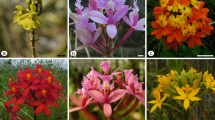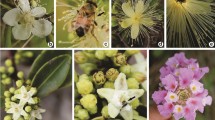Abstract
Key message
An unusual polyad occurs in three Parkia species, named cavitate polyad. It has an internal central space full of lipoprotein substances, contacting all pollen grains, probably aiding pollen germination.
Abstract
This study details the unusual morphology of polyads of three species of Parkia (P. multijuga Benth., P. ulei (Harms) Kuhlm., and P. pendula (Willd.) Benth. ex Walp.) and suggests functions for polyad adaptive traits that are linked to the reproductive success of the species. Polyads within the anthers of the three Parkia species were analysed by surface (scanning electron microscopy) and anatomical (light microscopy) studies. Ultrastructure and development studies were carried out for P. pendula polyads. Polyads are globose and cavitated, i.e., exhibit an internal cavity that varies in size, being more conspicuous in P. ulei and P. pendula. Other differences among species are related to the polyad size, exine ornamentation and the type of substances stored in the pollen grain. The polyad internal cavity is filled with an exudate that may be related to the pollen germination through the internal pores and/or translocation of substances from the anther loculus to the inside or vice versa. This inference is supported by the following observations: the spaces between the pollen grains in a polyad are also filled with the exudate, and the exudate inside the polyad is similar to the anther locular fluid. The morphology and substances stored within the pollen grains of Parkia polyads seem to be more related to polyad functionality and physiology than to the selective pressures exerted by different pollinators on the group.




Similar content being viewed by others
References
Arce LR, Banks H (2001) A preliminary survey of pollen and other morphological characters in neotropical Acacia subgenus Aculeiferum (Leguminosae: Mimosoideae). Bot J Linn Soc 135:263–270
Baker HG, Baker I (1979) Starch in angiosperm pollen grains and its evolutionary significance. Am J Bot 66:591–600
Baker HG, Harris BJ (1957) The pollination of Parkia by bats and its attendant evolutionary problems. Evolution 11:449–460
Basso-Alves JP, Agostini K, Teixeira SP (2011) Pollen and stigma morphology of some Phaseoleae species (Leguminosae) with different pollinators. Pl Biol 13:602–610
Feder N, O’Brien TP (1968) Plant microtechnique: some principles and new methods. Am J Bot 55:123–142
Feuer SM, Niezgoda CJ, Nevling LI (1985) Ultrastructure of Parkia polyads (Mimosoideae: Leguminosae). Am J Bot 72:1871–1890
Fitzgerald MA, Calder DM, Knox RB (1993) Character states of development and initiation of cohesion between compound pollen grains of Acacia paradoxa. Ann Bot 71:51–59
Gerrits PO (1991) The application of glycol methacrylate in histotechnology; some fundamental principles. Department of Anatomy and Embryology, State University Groningen, The Netherlands
Harder LD, Johnson SD (2008) Function and evolution of aggregated pollen in angiosperms. Int J Pl Sci 169:59–78
Hopkins HCF (1984) Floral biology and pollination ecology of the Neotropical species of Parkia. J Ecol 72:1–23
Hopkins HCF (1986) Monograph 43—Parkia (Leguminosae: Mimosoideae). In: Flora neotropica. The New York Botanical Garden, New York
Johansen DA (1940) Plant microtechnique. McGraw-Hill Book Company Inc., New York
Karnovsky MJ (1965) A formaldehyde-glutaraldehyde fixative of high osmolarity for use in eletron microscopy. J Cell Biol 27:137A–138A
Kenrick J, Knox RB (1979) Pollen development and cytochemistry in some Australian species of Acacia. Aust J Bot 27:413–427
Lewis G, Schrire B, Mackinder B, Lock M (2005) Legumes of the world. The Royal Botanical Gardens, Kew
Luckow M, Hopkins HCF (1995) A cladistic analysis of Parkia (Leguminosae: Mimosoideae). Am J Bot 82:1300–1320
Niezgoda CJ, Feuer SM, Nevling LI (1983) Pollen ultrastructure of the tribe Ingeae (Mimosoideae: Leguminosae). Am J Bot 70:650–667
O’Brien TP, Mccully ME (1981) The study of plants structure. Principles and selected methods. Thermarcarphy Ltd., Melbourne
O’Brien TP, Feder N, Mccully ME (1964) Polychromatic staining of plant cell walls by Toluidine Blue O. Protoplasma 59:368–373
Pearse A (1980) Histochemistry theoretical and applied, vol II, 4th edn. Longman Group Limited, London
Prenner G, Teppner H (2005) Anther development, pollen presentation and pollen adhesive of parenchymatous origin in Calliandra angustifolia (Leguminosae–Mimosoideae–Ingeae). Phyton 45:267–286
Reynolds EW (1963) Use of lead citrate at high pH as an electron opaque stain in electron microscopy. J Cell Biol 17:208–212
Roulston TH, Cane JH (2000) Pollen nutritional content and digestibility for animals. Pl Syst Evol 222:187–209
Santos FAR, Romão CO (2008) Pollen morphology of some species of Calliandra Benth. (Leguminosae–Mimosoideae) from Bahia, Brazil. Grana 47:101–116
Seijo JG, Neffa VGS (2004) The cytological origin of the polyads and their significance in the reproductive biology of Mimosa bimucronata. Bot J Linn Soc 144:343–349
Stroo A (2000) Pollen morphological evolution in bat pollinated plants. Pl Syst Evol 222:225–242
Teppner H (2007) Polyad development and karyology in Inga and Calliandra (Mimosaceae-Ingeae): a reply to a recent paper in Flora. Phyton Ann R Bot 47:1–46
The Legume Phylogeny Working Group (2013) Legume phylogeny and classification in the 21st century: progress, prospects and lessons for other species-rich clades. Taxon 62:217–248
Watson ML (1958) Staining of tissue sections for electron microscopy with heavy metals. J Biophys Biochem Cytol 4:475–478
Author contribution statement
Liana worked in the data collection and interpretation, in the arrangement of figures in plates, in the bibliographical survey and writing the manuscript. Simone worked in the supervision of data collection, data interpretation, correction of the plates and of the text.
Acknowledgments
We thank Edmárcio S. Campos (FCFRP/USP), Maria Dolores S. Ferreira, José Augusto Maulin (FMRP/USP) and Rodrigo F. Silva (FFCLRP/USP) for technical assistance. The authors have grant from the Conselho Nacional de Desenvolvimento Científico e Tecnológico (Process Number 302204/2012-1).
Conflict of interest
The authors declare that they have no conflict of interest.
Author information
Authors and Affiliations
Corresponding author
Additional information
Communicated by M. Shane.
Rights and permissions
About this article
Cite this article
Capucho, L.C., Teixeira, S.P. Morphology of the unusual polyad in Amazonian Parkia legume trees. Trees 28, 1507–1514 (2014). https://doi.org/10.1007/s00468-014-1055-5
Received:
Revised:
Accepted:
Published:
Issue Date:
DOI: https://doi.org/10.1007/s00468-014-1055-5




